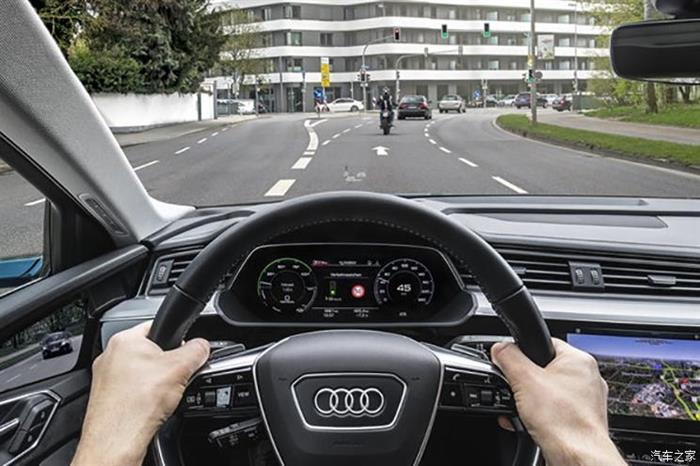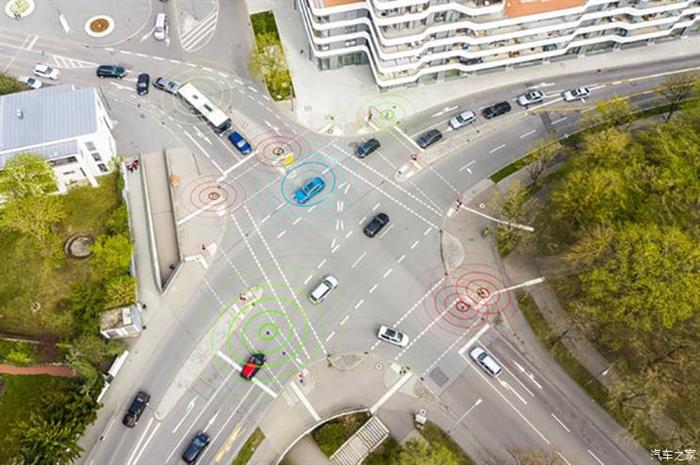Audi plans to launch a "traffic light assistance system" in Europe to achieve intelligent connectivity between vehicles and infrastructure (V2I). Audi said that starting from July this year, new Audi models will be fully connected to the local traffic light system in Ingolstadt, Germany. Starting in 2020, this technology will be promoted to more European cities.

Audi said that drivers will be able to experience the smooth driving experience brought by "full green light": even in the cockpit, Audi owners can know at what speed to drive to catch the next green light. When the road speed limit cannot catch up with the current green light, the vehicle will calculate the time to the next green light and count down for the owner. This assistance system will make city driving easier and more efficient.
“Stop-and-go traffic is a big part of the driving experience, so drivers are happy every time they see a ‘green light all the way.’ Unfortunately, this is rarely the case in cities. With Traffic Light Assistant, driving is under control, efficient and easy. Drivers will know if they can catch the green light within 250 meters of the light,” said Andre Hainzlmaier, head of Audi Apps, Connected Services and Smart City Development. “In the future, anonymous data from Audi vehicles will help cities’ traffic light systems switch more rationally and optimize traffic flow.”

Audi is the first automaker in the world to connect mass-produced models to the city's traffic light system. As early as the end of 2016, Audi had already applied this technology in the United States. Users can use the "green light countdown" function: if the driver arrives at the intersection and the light is red, the vehicle will display the next green light countdown through the virtual cockpit or head-up display. This service has covered more than 5,000 intersections in the United States and has been applied in cities such as Denver, Houston, Las Vegas, Los Angeles, Portland and Washington. In Washington alone, 1,000 intersections have been connected to the "traffic light assistance system" function.
Since February this year, Audi has further enriched the functions launched in North America, with the goal of making driving "green lights all the way". The "Green Light Optimal Speed Recommendation" function will suggest the ideal speed for drivers to reach the next green light.

Some Audi models will be able to implement the "green light countdown" and "green light optimal speed suggestion" functions in Ingolstadt, including all Audi e-tron models and Audi A4, Audi A6, Audi A7, Audi A8, Audi Q3, Audi Q7 and Audi Q8 models produced after mid-July. To achieve these two functions, the model must be equipped with the "Audi connect navigation and infotainment" component and the optional "camera traffic sign recognition" function.
In the coming years, Audi plans to roll out the Traffic Light Assistant system to more cities in Europe, Canada and the U.S. In Wuxi, China, Audi and its partners are working together on a project to test the interconnection between cars and traffic light systems.
Previous article:Cepton and Dataspeed collaborate to provide high-performance lidar for autonomous vehicles
Next article:Nissan develops autonomous driving technology and abandons LiDAR like Tesla
- Car key in the left hand, liveness detection radar in the right hand, UWB is imperative for cars!
- After a decade of rapid development, domestic CIS has entered the market
- Aegis Dagger Battery + Thor EM-i Super Hybrid, Geely New Energy has thrown out two "king bombs"
- A brief discussion on functional safety - fault, error, and failure
- In the smart car 2.0 cycle, these core industry chains are facing major opportunities!
- The United States and Japan are developing new batteries. CATL faces challenges? How should China's new energy battery industry respond?
- Murata launches high-precision 6-axis inertial sensor for automobiles
- Ford patents pre-charge alarm to help save costs and respond to emergencies
- New real-time microcontroller system from Texas Instruments enables smarter processing in automotive and industrial applications
- Innolux's intelligent steer-by-wire solution makes cars smarter and safer
- 8051 MCU - Parity Check
- How to efficiently balance the sensitivity of tactile sensing interfaces
- What should I do if the servo motor shakes? What causes the servo motor to shake quickly?
- 【Brushless Motor】Analysis of three-phase BLDC motor and sharing of two popular development boards
- Midea Industrial Technology's subsidiaries Clou Electronics and Hekang New Energy jointly appeared at the Munich Battery Energy Storage Exhibition and Solar Energy Exhibition
- Guoxin Sichen | Application of ferroelectric memory PB85RS2MC in power battery management, with a capacity of 2M
- Analysis of common faults of frequency converter
- In a head-on competition with Qualcomm, what kind of cockpit products has Intel come up with?
- Dalian Rongke's all-vanadium liquid flow battery energy storage equipment industrialization project has entered the sprint stage before production
- Allegro MicroSystems Introduces Advanced Magnetic and Inductive Position Sensing Solutions at Electronica 2024
- Car key in the left hand, liveness detection radar in the right hand, UWB is imperative for cars!
- After a decade of rapid development, domestic CIS has entered the market
- Aegis Dagger Battery + Thor EM-i Super Hybrid, Geely New Energy has thrown out two "king bombs"
- A brief discussion on functional safety - fault, error, and failure
- In the smart car 2.0 cycle, these core industry chains are facing major opportunities!
- The United States and Japan are developing new batteries. CATL faces challenges? How should China's new energy battery industry respond?
- Murata launches high-precision 6-axis inertial sensor for automobiles
- Ford patents pre-charge alarm to help save costs and respond to emergencies
- New real-time microcontroller system from Texas Instruments enables smarter processing in automotive and industrial applications
- EEWORLD University Hall----Principles of Automatic Control Lu Jingchao, Northwestern Polytechnical University
- The problem of combining Arm and Linux
- Bluetooth Protocol Analysis_Protocol Architecture
- How to calculate the power of the power amplifier under drain bias?
- EEWORLD University Hall----Application of isolated gate driver
- Development of image processing system based on TMS320C6657 dual-core DSP
- MM32F103 development board evaluation and suggestions for the development of domestic MCUs
- Basics of Model-Based GaN PA Design: GaN Transistor S-Parameters, Linear Stability Analysis, and Resistor Stability
- EEWORLD University ---- Getting started and improving vivado
- 【New Year's Festival Competition】+2019 Shopping

 Automotive Ethernet (written by the person in charge of BMW Ethernet)
Automotive Ethernet (written by the person in charge of BMW Ethernet)














 京公网安备 11010802033920号
京公网安备 11010802033920号